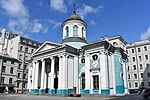Gostiny Dvor (Saint Petersburg Metro)

Gostiny Dvor (Russian: Гости́ный двор) is a station on the Nevsko–Vasileostrovskaya Line of the Saint Petersburg Metro. It was designed by architect C.G. Mayofis, E.S. Belyat, A.K. Andreyev, Ya.E. Moskalenko and C.P Schyukin and opened on November 3, 1967. It has two exits - one at the intersection between the Griboyedov Canal and Nevsky Prospect and another inside the northern side of the Gostinyi Dvor mall. The latter exit has an entrance that allows the commuters to enter the mall directly. The station also linked to the Nevsky Prospekt metro station via a transfer corridor and a set of escalators. The station is the busiest station on the line and one of the busiest stations in the entire St. Petersburg Metro.
Excerpt from the Wikipedia article Gostiny Dvor (Saint Petersburg Metro) (License: CC BY-SA 3.0, Authors, Images).Gostiny Dvor (Saint Petersburg Metro)
Nevsky prospect, Saint Petersburg Apraksin Dvor (округ № 78)
Geographical coordinates (GPS) Address Phone number Website Nearby Places Show on map
Geographical coordinates (GPS)
| Latitude | Longitude |
|---|---|
| N 59.934166666667 ° | E 30.333888888889 ° |
Address
Большой Гостиный Двор
Nevsky prospect 35
191023 Saint Petersburg, Apraksin Dvor (округ № 78)
Saint Petersburg, Russia
Open on Google Maps










